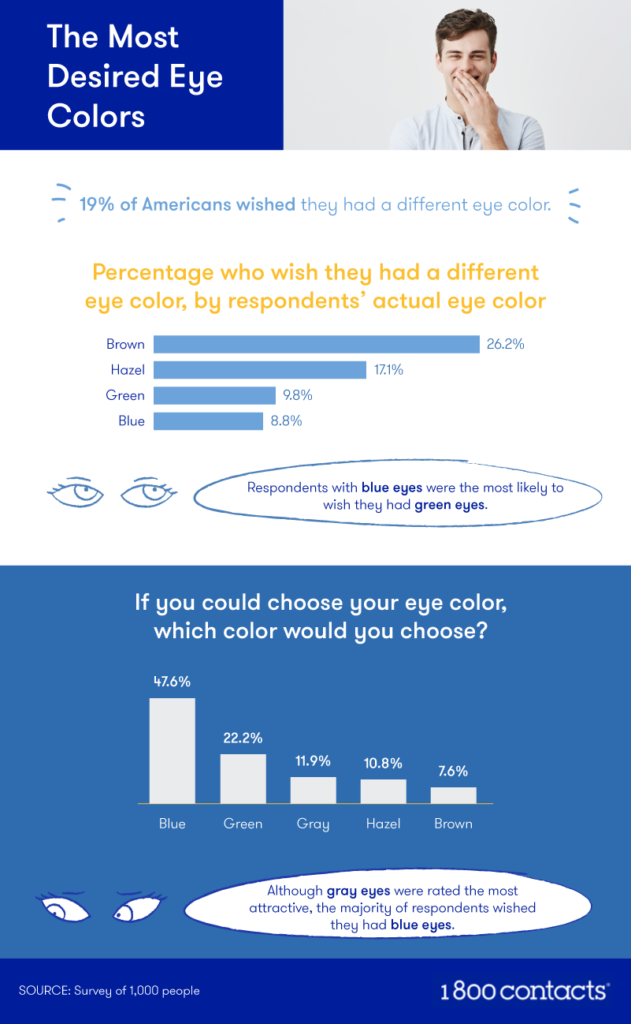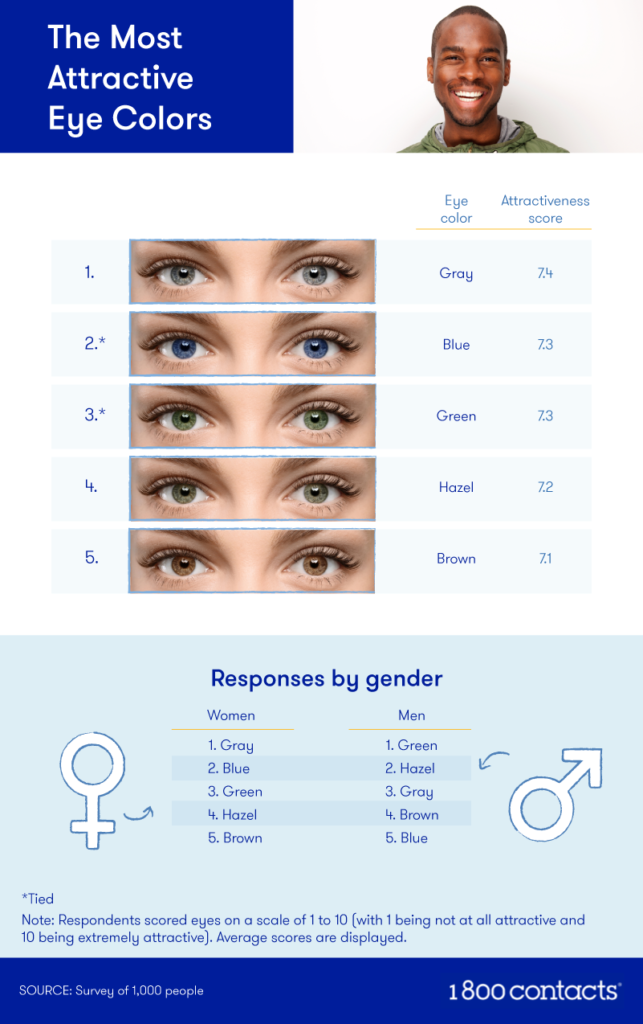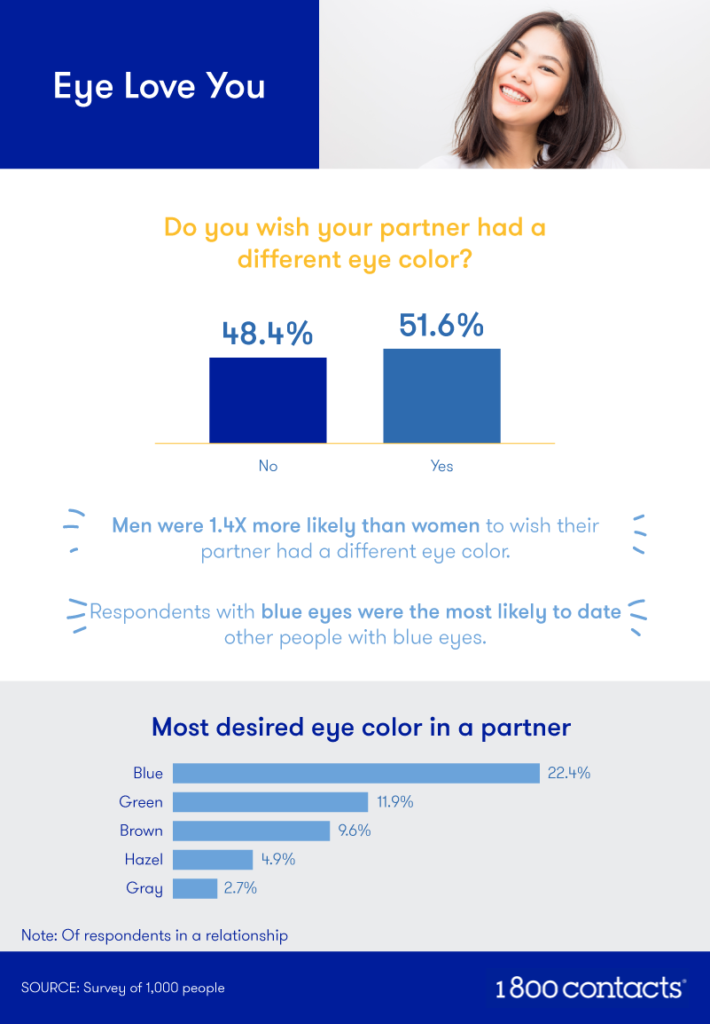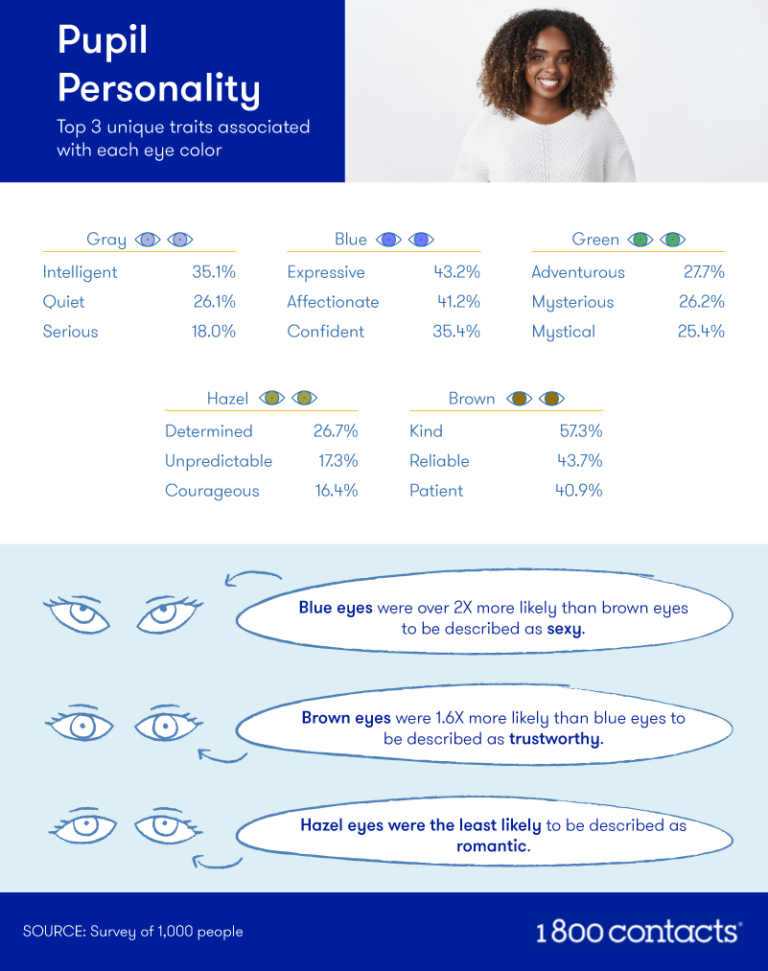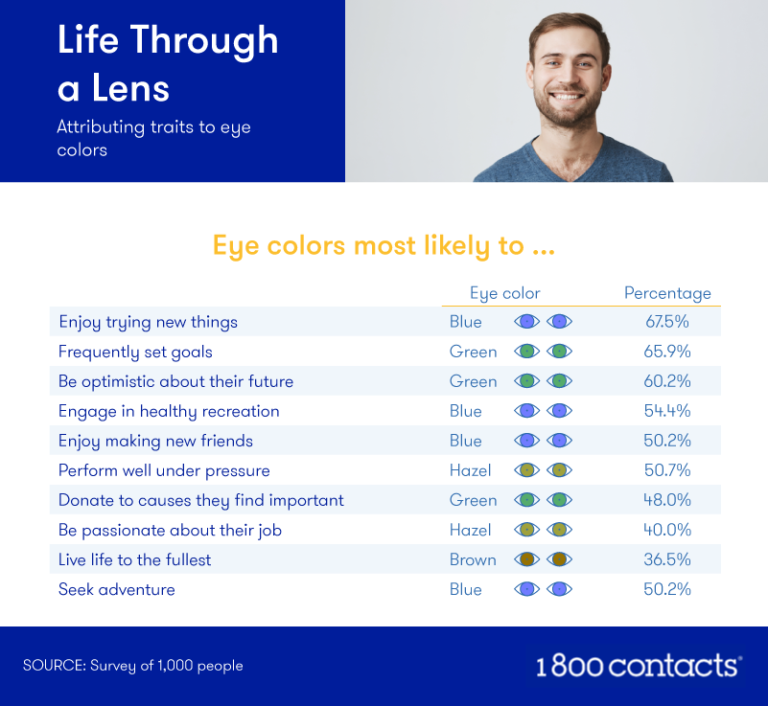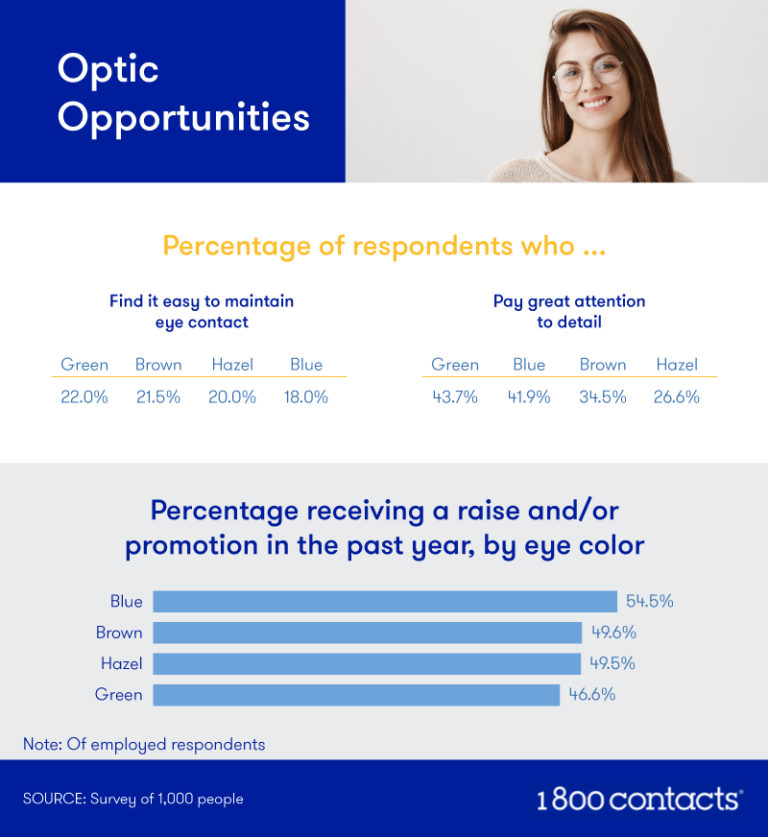Is the most attractive eye color in the eye of the beholder?
What’s the most attractive eye color? Well, it depends on who you’re asking. Still, polls, studies, and good old-fashioned curiosity suggest certain colors — especially rare ones — tend to get extra love.
One survey ranked gray eyes above every other shade, while a big poll of 66,000 people voted green eyes as the prettiest (which is it, people?). Then again, many folks go wild for bright blues, soft hazels, warm ambers, or timeless browns. Eye color love is totally subjective — which explains why there’s no official “Best Eye Color” award (but imagine the chaos if there were).
In this article, we’ll break down the rarest eye colors, see how genetics shape what’s staring back at you in the mirror, figure out why certain shades get so many compliments, and discuss which hues typically top the attractiveness charts (for men and women). We’ll also chat about any possible links to personality and explain how to change your eye color (yup, that's a thing) if you’re yearning for something new.
What is the rarest eye color?
Brown wins the U.S. eye color popularity contest — about 45% of people have some shade of brown. But if you’re in the market for rare, let’s talk green and hazel. Green clocks in around 9% of the population, while hazel rests at 18%. Gray is even less common (under 1% by some estimates), and blue sits pretty at 27%.
Here’s a quick rundown:
-
Gray eyes (1%)
-
Green eyes (9%)
-
Hazel eyes (18%)
-
Blue eyes (27%)
-
Brown eyes (45%)
True gray eyes are especially unique since there’s no actual gray pigment. It’s all about how light scatters off low melanin levels and high collagen. That’s why gray eyes can shift between blue, green, and silver depending on the lighting.
Rarest eye color: Gray
Gray eyes can flicker from bluish to greenish, turn slightly hazel, or stay a consistent, silvery gray. There’s no actual gray pigment, though. It’s all about how light scatters off low levels of melanin and high levels of collagen.
If you were lucky enough to be born this way, you probably get questions like, “Are you wearing contacts?” or “Wait, how do your eyes look different outside?” Lighting can cause some shapeshifting, making gray eyes as mystifying as they are downright cool.
Second rarest eye color: Green
Green eyes are tied to legends of witches, magical beings, and rebellious pop stars. Something about that lush shade spells intrigue. If you look closely, a green iris can have flecks of gold or even brown near the center, courtesy of melanin distribution. That multicolored effect can shift slightly with your wardrobe or environment, too. In short, green eyes give limited-edition-collectible vibes.
What determines eye color?
Ever wonder why your eyes are green when both your parents have brown? Or how your grandpa’s gray eyes skipped two generations before showing up in your baby? It’s all about genetics and melanin.
Genetics
Eye color isn’t as simple as "brown is dominant, blue is recessive." Around 16 genes work together to produce eye color — like an elaborate recipe with lots of hidden ingredients. The big players are OCA2 and HERC2 (on chromosome 15), but it’s not a simple on/off switch. That’s why two brown-eyed parents can have a blue-eyed child — genetic “hidden cards” sometimes surface unexpectedly.
Melanin
Melanin is the pigment that determines eye, skin, and hair color.
-
Lots of melanin: Brown or near-black eyes
-
Medium melanin: Hazel or green
-
Low melanin: Blue or gray
Babies are often born with gray or blue eyes because melanin production hasn’t kicked in yet. Eye color typically settles by age three — unless you try colored contacts (more on that later).
Most attractive eye colors
Beauty is in the eye of the beholder, but certain polls and studies do produce interesting trends. Generally, rare colors generate extra hype. Imagine you see 20 brown-eyed folks a day — then, someone floats in with bright green, jewel-amber, silver-gray, or striking hazel eyes. You might do a double take purely out of novelty. But that doesn’t mean you can’t find dark brown eyes to be the prettiest hue on earth if it reminds you of your first love or favorite celebrity.
Here’s a quick ranking:
-
Gray eyes: Mysterious, stormy, and less than 1% worldwide. Many rank them top-tier for sheer novelty.
-
Green eyes: Frequently called “the most beautiful,” also delightfully rare. Often described as enchanting or seductive.
-
Blue eyes: The classic that’s praised in songs, poems, and pop culture. Though not that rare, it’s still relatively uncommon. Many associate blue eyes with youthfulness or intelligence.
-
Hazel eyes: A blend of brown, green, gold, and yellow that seem to shift depending on light or clothes. This chameleon factor wows people, landing hazel in the top half of attractiveness surveys.
-
Brown eyes: The eye color of the majority. Because it’s so common, some polls rank it lower for novelty. But brown eyes have their fans, and they're cited as warm, loving, soulful, or comforting.
These rankings are just trends — not hard facts. There’s a reason Van Morrison sang about his brown-eyed girl, and plenty of people lose their minds over deep brown or bright blue eyes.
What is the most attractive eye color for a male?
In one survey, women favored green on men, with hazel and gray trailing close behind. Maybe green signals a dash of mystery that’s alluring. Women also described men with gray eyes as distinguished — like a storm cloud swirling with depth. Of course, your mileage may vary. Ryan Gosling is famously blue-eyed, and no one seems to mind.
What is the most attractive eye color for a female?
Men in the same poll leaned toward gray for women, labeling it “most attractive.” Next up were blue and green. Brown didn’t quite make the top three. Perhaps men find the less-common hues especially striking. Or maybe it’s because the media often features bright-eyed actresses. Interestingly, though men rated gray the top choice overall, many still said if they could pick a color for their dream partner, they might choose blue or green. Go figure — polls can be contradictory, just like real human preferences.
Is eye color linked to personality?
Pop psychology loves to link eye color to personality — but science says… not so much.
You’ve probably heard stuff like:
-
Brown-eyed people: Trustworthy and dependable
-
Blue-eyed people: Smart and sensitive
-
Green-eyed people: Creative and mysterious
-
Gray-eyed people: Wise and calm
-
Hazel-eyed people: Unpredictable and fun
Fun? Sure. Scientific? Nope. Still, first impressions can stick — so if you want to lean into your color’s stereotype (or completely flip it), go for it.
Interestingly, some research suggests light-eyed folks might see better in dim light, and brown-eyed people might be perceived as more trustworthy. But that’s about it — no one’s getting hired or dumped based on eye color alone.
But what if you could choose your eye color?
Raise your hand if you’ve daydreamed about waking up with a different eye color. A lot of folks with brown eyes fantasize about blue or green, purely out of novelty. Conversely, plenty of blue-eyed folks wonder if they’d look sultrier with dark brown or hazel. Modern contact lens technology means you can try on a new pair of peepers — just ask your eye care professional and snag some colored lenses.
Does pigment dictate personality?
Some polls say brown-eyed folks are seen as dependable, green-eyed ones as mysterious, blue-eyed folks as friendly, and gray-eyed ones as wise. Are you stuck with these labels? Absolutely not.
Personality is shaped by upbringing, genes, experiences, and about a thousand other factors. Eye color is just window dressing. Still, first impressions can stick. If you want to lean into your color’s stereotype — or flip it on its head — go for it.
Interestingly, research suggests light-eyed folks might see better in dim light, and brown-eyed people might be seen as more trustworthy in certain contexts. But it’s all pretty minor stuff — no one’s getting promoted (or dumped) because of eye color.
What do eye colors symbolize?
Eye colors have inspired enough folklore and superstitions to fill a library. Whether your gaze is a cozy brown or a lightning-bright blue, cultures around the world have plenty to say about the meaning behind your irises. Let’s have some fun and see what each color supposedly signifies.
Brown eyes: warmth and reliability
Brown is the most common color, often symbolizing stability, security, and gentle strength. Literature references “kind, brown eyes” or “doe-eyed sweetness.” Brown can also be seen as down-to-earth or approachable. Think of a comforting mug of hot cocoa on a chilly day.
Blue eyes: youth and openness
Blue often stands for innocence or clarity, like a clear sky. Cultural norms in some areas idolize bright blue eyes as the pinnacle of beauty. On the flip side, certain literary works paint icy blue eyes as intimidating. So, again, it’s context-driven — but overall, blue is widely viewed as fresh and smart. Perhaps that's why so many U.S. presidents boasted baby blues.
Green eyes: mystery and vibrance
Green eyes are frequently linked with creativity, self-reliance, and a dash of the unknown. Witches, magical beings, and mythical characters in fiction often flaunt emerald irises. There’s also the “green-eyed monster” for jealousy, so it’s a color that can signal strong passions — good and bad.
Hazel eyes: versatility and energy
Hazel can appear to shift between brown, gold, green, and even gray. Symbolically, shape-shifting suggests adaptability or spontaneity. Hazel-eyed folks might hear, “Wow, your eyes look different today!” a lot, lending them a reputation for being unpredictable or fun-loving.
Gray eyes: wisdom and calm
Gray suggests neutrality, steely resolve, a balance of opposites, or a blend of black and white, so symbolism can skew toward wisdom, power, perspective, or stoic composure. Think a blend of tough metal and mist. In some tales, a character with gray eyes is the sage mentor or the quietly intense leader who sees all sides.
Amber eyes: boldness and uniqueness
Amber resembles molten gold — striking, intense, and relatively uncommon. Many animals have amber eyes (like wolves), which can give human amber eyes an otherworldly or wild flair. People might associate them with vitality, courage, or a fierce presence.
What about colored contacts?
If you want to see life through a different hue — no permanent changes required — colored contact lenses are your best friend. It’s like sampling new hair colors, only for your eyes. Depending on the shade you choose, you can subtly enhance what you’ve already got or go for a full-on color swap.
At 1-800 Contacts, we offer loads of colored lens options. You’ll still need a valid prescription from your eye care professional (even if your vision’s perfect, you need a fitting for eye health). Once that’s sorted, you can pick lenses that suit your comfort level:
-
Enhancement tints: Semi-transparent, great if you have light eyes and want a slight color boost.
-
Opaque tints: Fully cover your natural color. If you’ve got brown eyes and dream of glacial blue, these are your ticket.
-
Visibility tints: A faint tint mainly for locating the lens (not for color-changing). Useful if you tend to drop or misplace your contacts.
Safety and comfort
Colored contacts are still medical devices — meaning you should handle them like regular prescription lenses. Skip the novelty shops or unverified online sellers, because ill-fitting or unapproved contacts can damage your eyes. Go with a reputable source, and follow the same hygiene rules: wash hands, replace them on schedule, don’t sleep in them unless they’re specifically approved for overnight wear. (Zombie eyes are cool on Halloween, but we don’t want real-life horror stories with infections.)
Making it yours
Whether you’re going for a subtle shift (brown to hazel) or a drastic transformation (brown to gray, anyone?), pick a color that excites you. Some folks like daily disposables so they can swap colors on a whim, while others prefer monthly lenses for consistent style. The main point is to have fun experimenting. Life’s too short to wonder “What if?” about green eyes — just try them for a weekend.
Wrapping it all up
We’ve explored which eye colors rank as the most attractive, dug into the rarest shades, and uncovered why green or gray might catch our attention more than everyday browns. We’ve also peeked at how genetics shape your iris, chatted about a few myths, and covered how to change your color with safe, approved lenses. The big lesson? Eye color is a fascinating detail, but it’s not the entire story. You can have mesmerizing hazel eyes and still be hopelessly shy, or have bold blue eyes and be 100% trustworthy.
At the end of the day, the most attractive eye color is whatever shade makes you feel your best. If you’re lucky enough to love your natural color — fantastic. If you’d rather test out a new hue, colored contacts are there for you. Either way, confidence and kindness light up your eyes more than any pigment. After all, the real magic is how you use that gaze to connect with the people around you.
Ready for a fresh look?
If you’re longing to experience life as a green-eyed charmer or simply want to add a little more pop to your natural hue, colored contacts might be your perfect match.
1-800 Contacts can help you find the perfect colored lenses (and yes, your prescription matters, even for a purely cosmetic change). Our mission is to make your eye care journey easy and maybe even fun.
Check out our colored contacts collection, whether you’re after a subtle enhancement, a dramatic swap, or just a hint of tint. We’ll guide you through choosing the right brand and style, so you can see clearly and look amazing in your new hue. Go ahead — your dream eye color is only a few clicks away.
Did you know you can order contacts online?
Say goodbye to trips to the eye doctor and hello to convenience! With 1-800 Contacts, you can easily order your contact lenses online and have them delivered straight to your door. Plus, our online vision exam makes it simple to get the prescription you need without leaving home. And the best part? You’ll save money on your first order with 1-800 Contacts. It’s never been easier to get your contacts!
Fair use statement
Eye color reveals so much more than our genetic makeup, but most people don’t know how it affects the way they are perceived. If you know someone who would be interested in the findings of our study, feel free to share this project with them. The graphics and content found here are available for noncommercial reuse. We just ask that you link back to this page so that the authors receive proper credit.
Original published date: 1/24/2020
Updated: 4/23/25
Original Author: Austin Brewer






